Customer Journey Map: Get To Know, Design, and Use Them
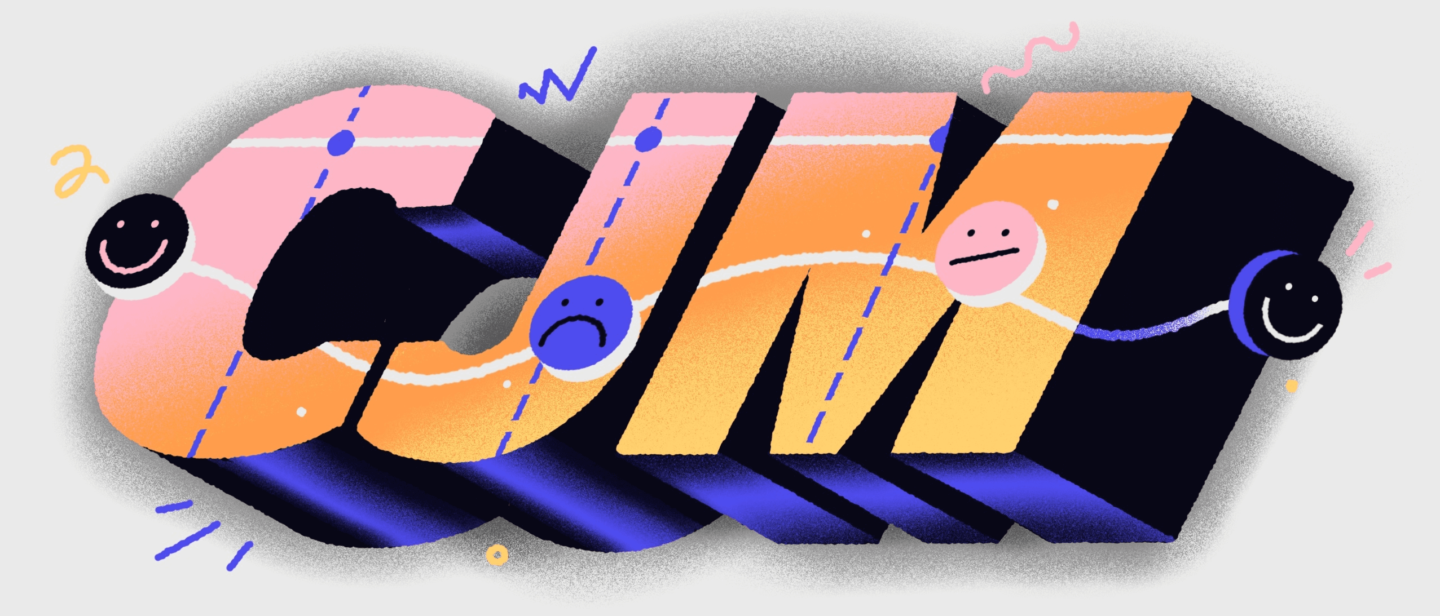
Did you ever wonder what product managers and marketers want? Digging into customers’ heads, for sure. What are they thinking? What makes them happy or sad? How do they decide to buy?
The Customer Journey Map is what can help you address these questions.
What’s the Customer Journey Map?
The Customer Journey Map (or CJM) describes the customer’s journey from where they don’t even know you to where they buy from you and beyond.
Note: CJM is all about the customer journey. A customer may buy your product for another person to use it. From this point onward, when we use the term “customer”, we imply a person looking for a product, choosing and buying it. The actual user may either be the same or another person.
The Сustomer Journey Map sheds light on your customer’s unmet needs and issues they may have when dealing with your company. You can improve the customer experience dramatically with this knowledge on your hands.
There are other maps besides the CJM: UJM, Customer experience map, canvas, Service Blueprint. The approach to map design is the same. We’ll elaborate on the differences in a mere moment.
Why design the CJM?
Journey mapping demonstrates the user interaction with your product. The map highlights minor interactions, emotions, and all other factors affecting the purchase decision which you may not see in your funnel.
- Journey mapping highlights the pros and cons of your marketing strategy
If a customer can quickly proceed from one stage to another and feel good, you’re doing great. Memorize these things and work on them. And remember this: all customer issues are yours — these are the things you should address first.
- Journey mapping helps you visualize the customer experience and make it manageable
If you’re on the same page with your audience, you know what you can do to make them buy.
Enjoy every little detail about your customers with Dashly. Understand who you are talking to and what they need to offer the best solution. Track:
• Emails, phone numbers, and exit intents.
• Page visits, button clicks, and field-filling events.
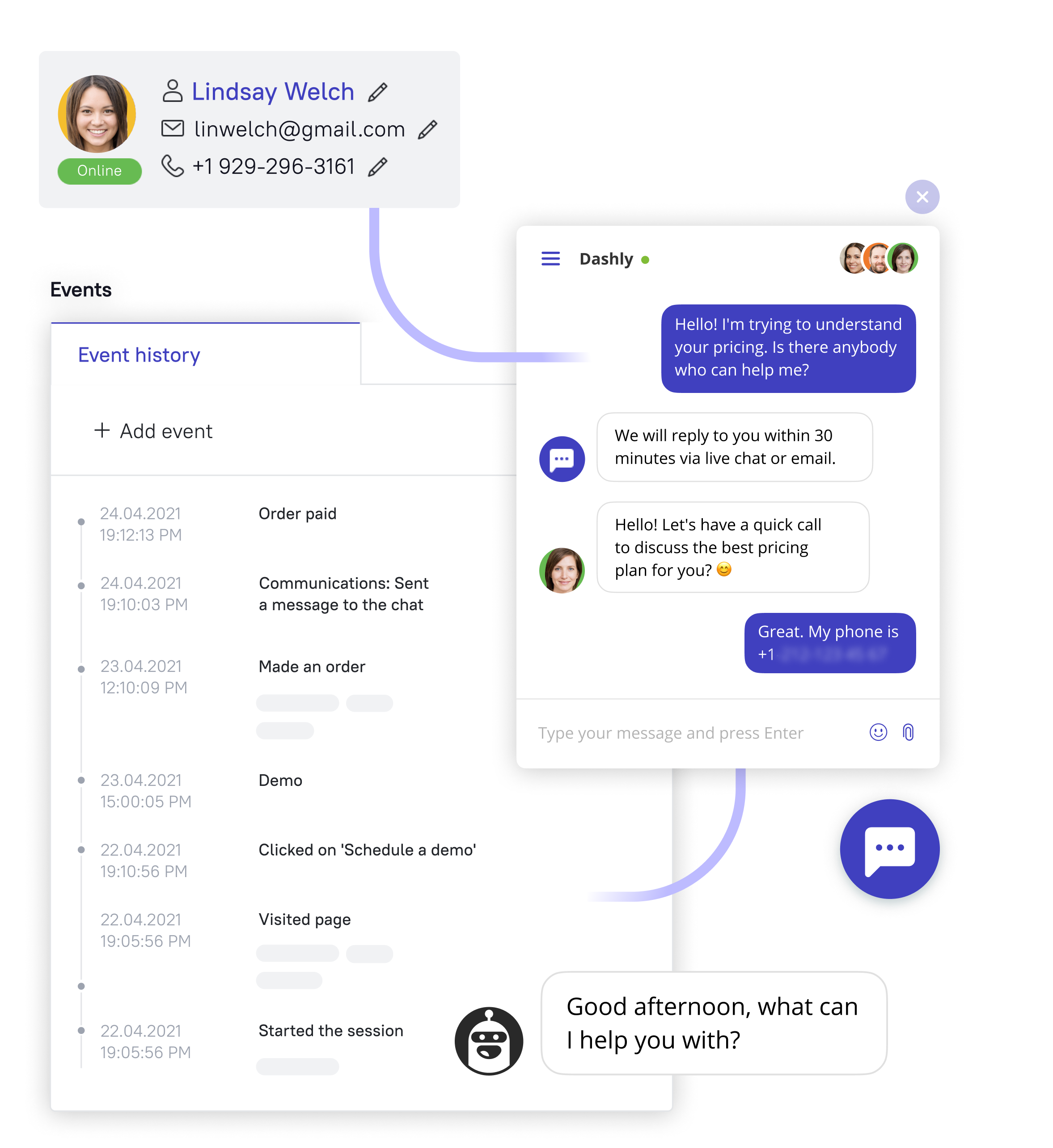
What CJMs are there?
Essentially, journey mapping implies a graph where you insert stages of user interaction, customer touchpoints, user actions, and their feelings.
Target audiences are what make all maps different. That explains why customer journey maps may have different names.
- The customer journey map demonstrates how your customer engages with your company and decides to buy from you.
- The user journey map (or UJM) is a map of your user’s journey within your product. That’s precisely the person using it.
Let’s say your product marketer decides you need a single point of contact that will handle all user communication. Support agents and assistants are going to be this service’s users. User journey map will reflect their usage experience. - The life experience map (or LXM) is a lifetime customer map. Design it if you wonder what other needs your product can cover, where you should be headed, and how else you can improve your users’ lives.
- Another map is Service Blueprint. Essentially, it’s a framework of the company’s business processes laid over the CJM. You can use it to see which teams are responsible for what and what touchpoints there are, what processes should be adjusted or added to improve the interaction.
At different stages of user interaction with your product, you may have several UJMs within one CJM. That’s why these notions are often mutually replaced.
Get a free audit of your customer journey and improve conversions
Let’s schedule a 30-minute call and find out how to:
- Improve your website conversion.
- Grow your ROI/ROMI with proven hypotheses that fit your audience.
- Optimize or launch ad channels without additional budget.
- Decrease SLA workload by saving their time on lead processing.
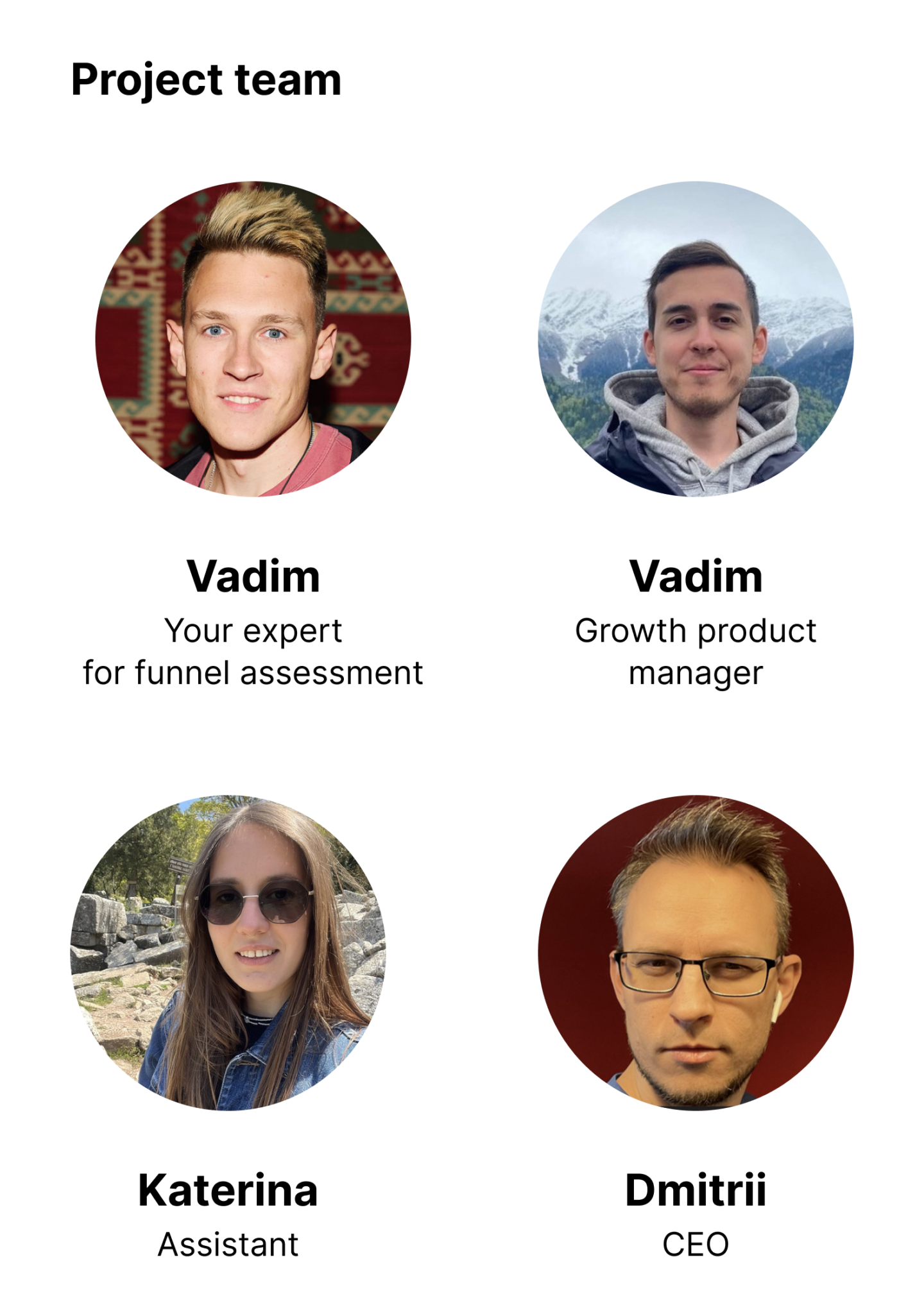
The three CJM templates
CJM for b2c
The digital travel agency’s customer journey map describes customer actions, expectations, and emotional reactions.

Customer journey map + Service blueprint
See the example of a complex customer journey map with the company’s business processes map below. Each dot shows what team is responsible for what. This handy map shows growth areas for user communication and their possible roots.

Customer journey map for b2b
See the CJM example for b2b companies. If we remove the bright colors, we’ll see the stages and details at the core that influence purchasing decisions in b2b: several decision-makers, long deal cycles, etc.
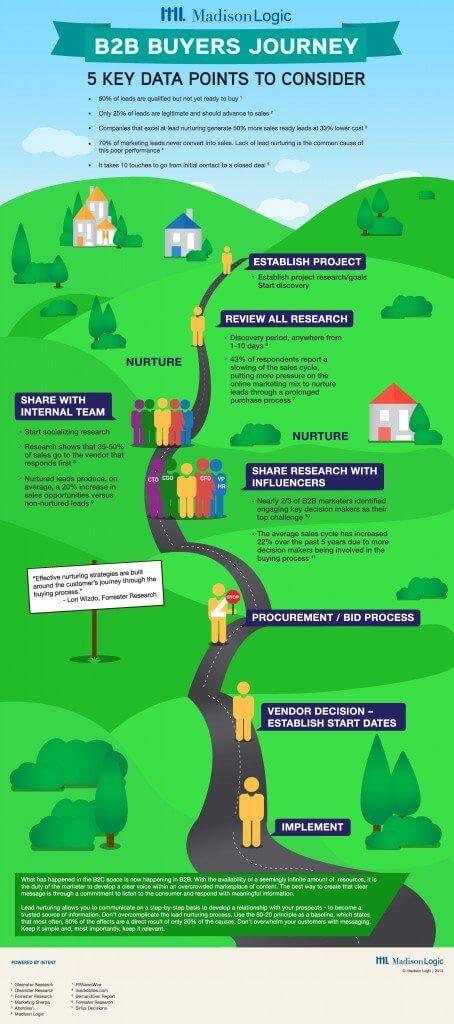
Download 41 templates of growth marketing campaigns to optimize each step of your customer journey
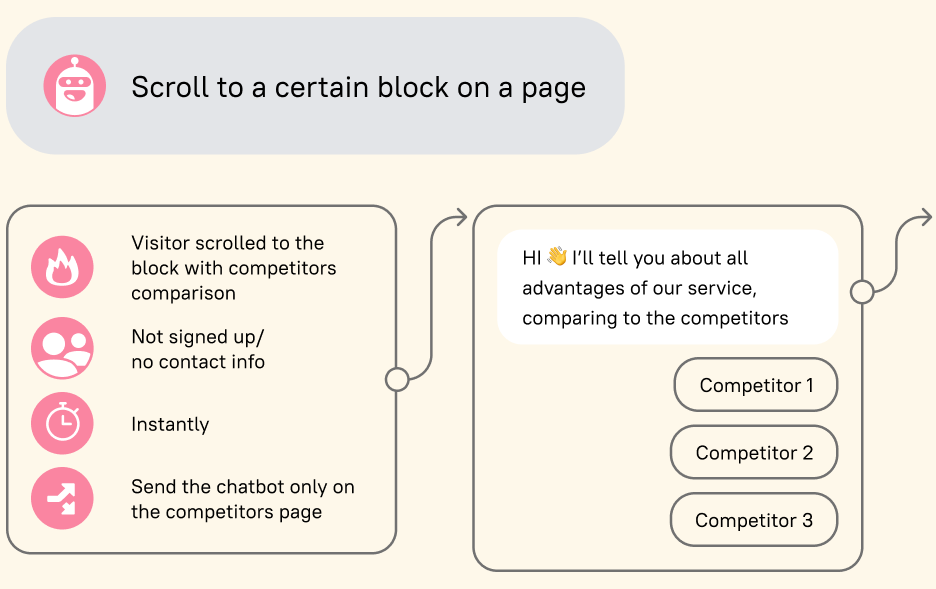
Five steps towards the CJM that works
- Collect your audience data
- Portray the buyer personas
- Describe how your customer proceeds from seeing their need before interacting with you to repeat transactions
- Go over your customer journey map and handle bottlenecks
- Start all over again
We’re happy to share a detailed guideline with you. It’ll help you collect the data you need and structure it so that you can see how your customer proceeds along the funnel. You’ll see new opportunities to reduce churn and make your conversion rates skyrocket.
Step one: Collect your audience data
1. Remember the target audience research you already did
It’s highly likely that you already collected customer data. You can make good use of it, just don’t forget to ensure their usability with these questions:
- When were these data collected?
- Is the data still relevant for my potential customers?
- Does my product help these people solve their issues?
2. Run a survey to refresh your customer data
Use these lists for reference to collect new customer data.
Open-ended questions:
- How do you feel using the product? What makes you happy and what irritates you?
- How was your purchasing experience?
- Which information could facilitate your purchasing process?
- What can make you change your mind?
Close-ended questions:
- How likely are you to buy this product again?
- Did you use social media to find out about the product?
- How often do you use the product?
- Personal details: gender, age, place of residence
You can use Google Forms or Survey Monkey to run a survey and customer emails or social media to distribute your questionnaire. Remember that not all customers may find the time to complete it. The shorter your survey and questions, the higher the odds customers complete it.
3. Collect website & social media analytics
The more you know, the better your customer journey map. Collect data from your website analytics and social media. You’ll see where users come from, how they interact with your website, and what issues they face.
4. Talk to your teammates on the front line
Sales reps know all about barriers customers may have, and tech guys know issues that users encounter. You need this precious information to describe your users’ stories in the customer journey map.
Ask your teammates these questions:
- What are the most common issues that customers face?
- What is the most impressive thing about our product?
- What obstacles do they face?
- What do they ask looking for a solution?
5. Talk to your customers
Refer to your customers personally to hear what you need the most from them.
It’s highly likely that customers will share their pains during a personal conversation. This will greatly augment what you collect with a questionnaire.
Use this question list as a reference and begin with 5-10 customers:
- How did you find out you needed the product?
- What made you look for an alternative as you didn’t buy the product?
- What were you willing to solve with the product?
- Was it hard to find any product details?
- What would facilitate the purchasing process for you?
- What would improve your experience with the product?
Get a free website audit and improve your conversions with Dashly experts
Let’s schedule a 30-minute call and find out how to:
- Improve your website conversion.
- Grow your ROI/ROMI with proven hypotheses that fit your audience.
- Optimize or launch ad channels without additional budget.
- Decrease SLA workload by saving their time on lead processing.

Step two: Portray the buyer personas
The main characters of your customer journey map are the buyer personas of your customers.
A buyer persona is a generalized character of one of your customer segments. They have mutual behavioral patterns, ways of thinking, goals, values, etc.
You’ll need several personas for the customer journey map. All people approach their issues differently and may come to your product via different paths.
Stick to precise wording when describing personas. Use the collected data as a grounding for persona description.
You can describe a persona using these data:
- age
- gender
- occupation
- place of residence
- lifestyle
- behavioral patterns
- goals and values
- devices used
- opinion leaders
- issues that your product is hired to resolve.
This will help you see how customers proceed to buy from you, what they rely on, and what may push them away.
Step three: Describe how your customer proceeds from seeing their need before interacting with you to repeat transactions
Rely on the real customer behaviors rather than your business processes, though they are often more chaotic and inconsistent.
Here’s how you may plan your questions to design each stage of your customer journey map:
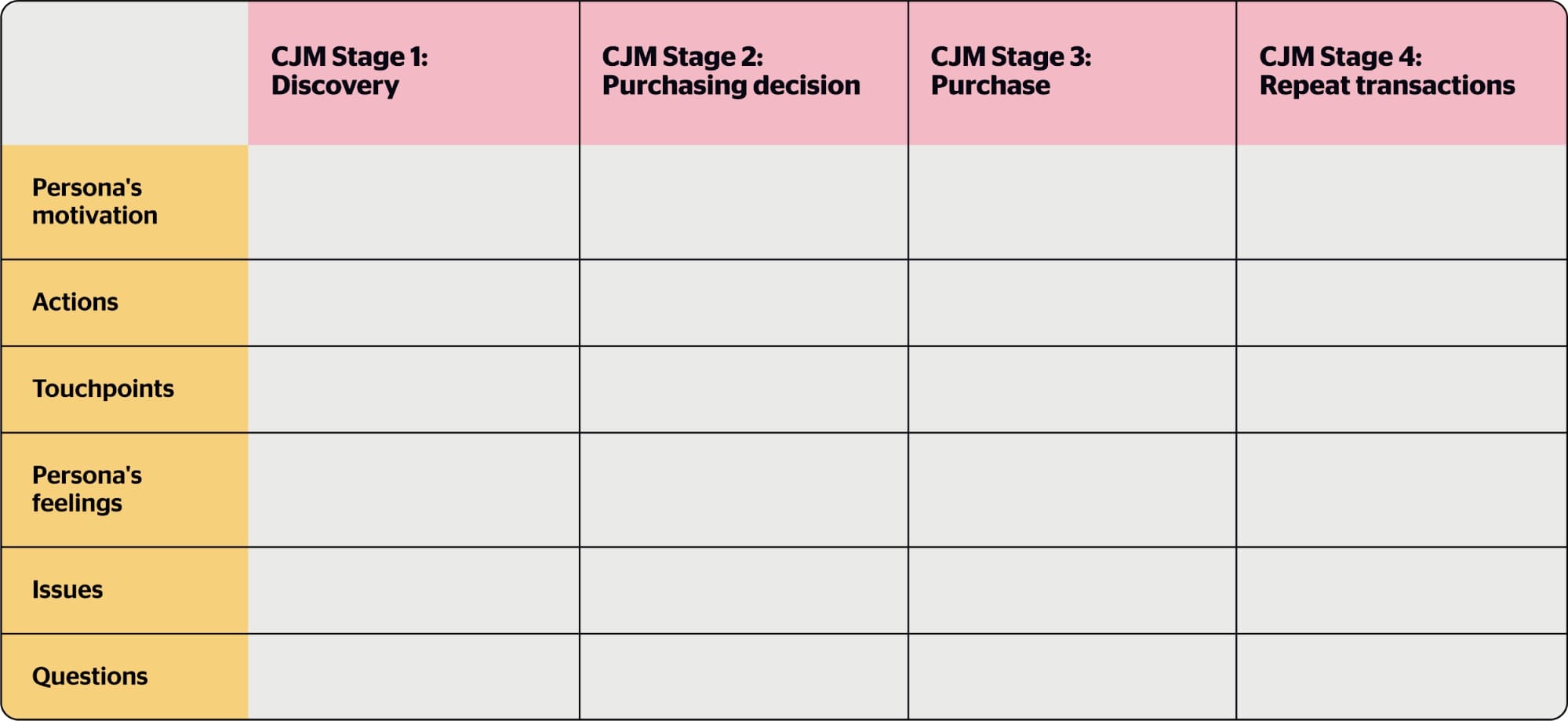
Let’s consider a case. Suppose you’re an owner of an online clothing store called ESOS. One of your personas is Alice, 25, a marketer. She’s going to her sister’s wedding, where she’ll be a bridesmaid. Let’s see how we can plot Alice’s journey from the beginning of her search for a perfect outfit to placing an order in your online store.

CJM Stage 1: Discovery
Your persona may fall in love at the first sight, but that doesn’t happen often. Let’s see what’s going on with Alice during Stage 1:
Persona’s motivation
Find a reason why your persona is looking for your product. This should be something they cannot do without you.
The reason in our case is an upcoming event for which Alice needs to find an outfit.
Hidden motivation
These are the things your persona is unlikely to articulate, but they will influence their buying decisions. You should also consider hidden motives in your customer journey map.
At the wedding, Alice will bump into her ex, so she needs to look fabulous.
Persona’s actions
Alice opens the Telegram channel of a famous stylist posting selections of nice outfits. She finds a dress from your website, follows the link, sees that her size is out of stock, and continues her search directly on the website.
Touchpoints
Describe how a customer interacts with a company that will resolve their issues for the first time.
Alice’s starting touchpoints:
- Link in a Facebook group
- She follows the link
- She sees the product page for the first time
- She follows recommendations
See which devices and channels your persona uses to get the information. Consider both online and offline sources: search engines, ads in social media or messengers, media, blogs, forums, word of mouth, etc.
Let’s get back to Alice. She has no time for offline malls; she prefers online shopping, follows some Telegram channels about fashion, and reads their updates on her phone, and googles online shops procrastinating at work.
Persona’s feelings
The emotional side of your user’s story begins with appreciating an issue that needs to be solved.
Let’s continue with our example:
- Alice is excited about her sister’s wedding;
- She’s annoyed by the news that her ex is invited;
- She’s upset about having to look for a dress;
- She’s upset about having no time and energy for shopping;
- She feels hopeful about online shopping;
- She’s delighted to see dresses that she likes.
Issues & Questions
Let’s see which difficulties Alice might experience:
- No time for shopping before an important event;
- Animus towards malls;
- Her size is out of stock on the website;
- A fear that her dress won’t match the size chart and images on the website.
If you foresee the questions that can hold customers back, you’ll offer them timely help with a triggered message in live chat or useful content that will help them make a choice.
What questions Alice may ask:
- How to choose an online store?
- How to define my size?
- Does this thing match images from the website?
CJM Stage 2: Purchasing decision
Now the persona knows about your product and starts to think if they need it. Keep following the plan:
Motivation to learn more
Alice knows she can find the solution in a particular online store. You need to push her to know more about it and buy.
Persona’s actions
Alice’s actions can be described like this:
- She views the evening dress section and sticks to two options;
- She wants to add dresses to her favorites, but she needs to sign up to do that;
- She signs up in one click with her Facebook account;
- She looks for the size chart; for user reviews and advice on choosing a size; for details about the delivery cost; details on return policy because she can’t decide between her two options; payment methods to find the best one for her.
This is not a complete list, of course. Describe the persona’s actions in full in your customer journey map.
Touchpoints
- Product pages
- Signup page
- “Favorites” page
- FAQs
- Checkout
- Reviews online
Persona’s feelings
- Alice is delighted to see several possible solutions to her issue;
- She signs up easily because she doesn’t have to fill in a lot of fields;
- She’s occupied with the difficult choice between two options;
- She’s worried that the size won’t fit;
- After reading some good reviews, she feels confident about ordering.
Issues & Questions
It’s especially important at this stage to foresee customer questions and possible difficulties. You won’t feel good if your customer decides in favor of a competitor, do you agree?
Alice may feel confused about bad reviews on the fabric quality or long delivery. She may also experience difficulties looking for return policy details.
What might Alice wonder when making a purchase decision?
- What’s the required minimum order value for free delivery?
- Does her size match a suggested one?
- Can she find another dress if these two don’t fit?
Get a free website audit and improve your conversions with Dashly experts
Let’s schedule a 30-minute call and find out how to:
- Improve your website conversion.
- Grow your ROI/ROMI with proven hypotheses that fit your audience.
- Optimize or launch ad channels without additional budget.
- Decrease SLA workload by saving their time on lead processing.

CJM Stage 3: Purchase
See what made your customer buy and what was the decisive factor.
Motivation to buy a product
Let’s say Alice already spent some time looking for dress options and she doesn’t want to do the same in another store. She found the size and delivery details sufficient to dispel her doubts. She likes the dresses she chose. Alice doesn’t want to spend more time on her issue and she’s ready to place an order.
Persona’s actions
- Alice adds products from her favorites to the shopping cart;
- She fills in her order form; chooses a convenient payment method and pays for her order.
Touchpoints
- Basket page
- Checkout page
- Payment gateway
Persona’s feelings
- Alice feels relieved and happy about solving her issue;
- She is happy about free delivery;
- She feels calm about her money because the payment system is familiar.
Issues & Questions the persona may have
It’s crucial at this stage to iron out the wrinkles because they may dramatically influence customer experience and repeat purchases.
Luckily, Alice made it through this stage smoothly.
But still, she might have these questions:
- How do I fill in the postal code when ordering?
- Can I pay for my order upon delivery?
- When will my order be delivered?
Download 41 templates of growth marketing campaigns to optimize each step of your customer journey

CJM Stage 4: Repeat transactions
We already told you many times how important it is to work on customer retention. Loyal customers generate you most profits, that’s why you need to understand why customers make repeat transactions or not.
Put down everything that happens after a transaction.
Persona’s actions
- Checks her inbox waiting for an order confirmation and delivery terms;
- Receives the order tracking code and tracks their order;
- Sees the delivery person and gets their parcel;
- Puts on the dresses from her order;
- Decides on what to return;
- Returns the dress that didn’t fit.
Touchpoints
- Order confirmation page
- Order confirmation email
- An email with a tracking code
- Delivery person
- “Returns” page
- Return pick point
Persona’s feelings
- Alice feels anxious if she doesn’t have an email with the order tracking code;
- She feels relieved finding this email in her Spam folder;
- She feels happy getting her parcel;
- She looks at herself in the mirror enjoying the reflection when she tries her new dress on;
- Quick return and refund procedures make her even happier.
These are the questions she might be having:
- When will I get the order confirmation?
- How can I track my order?
- How do I return things?
Motivation to buy a product again
Alice is happy with her wedding dress experience and returning the extra dress. When facing the same issue (vacation outfits in this case), she prefers a familiar online store to solve it.
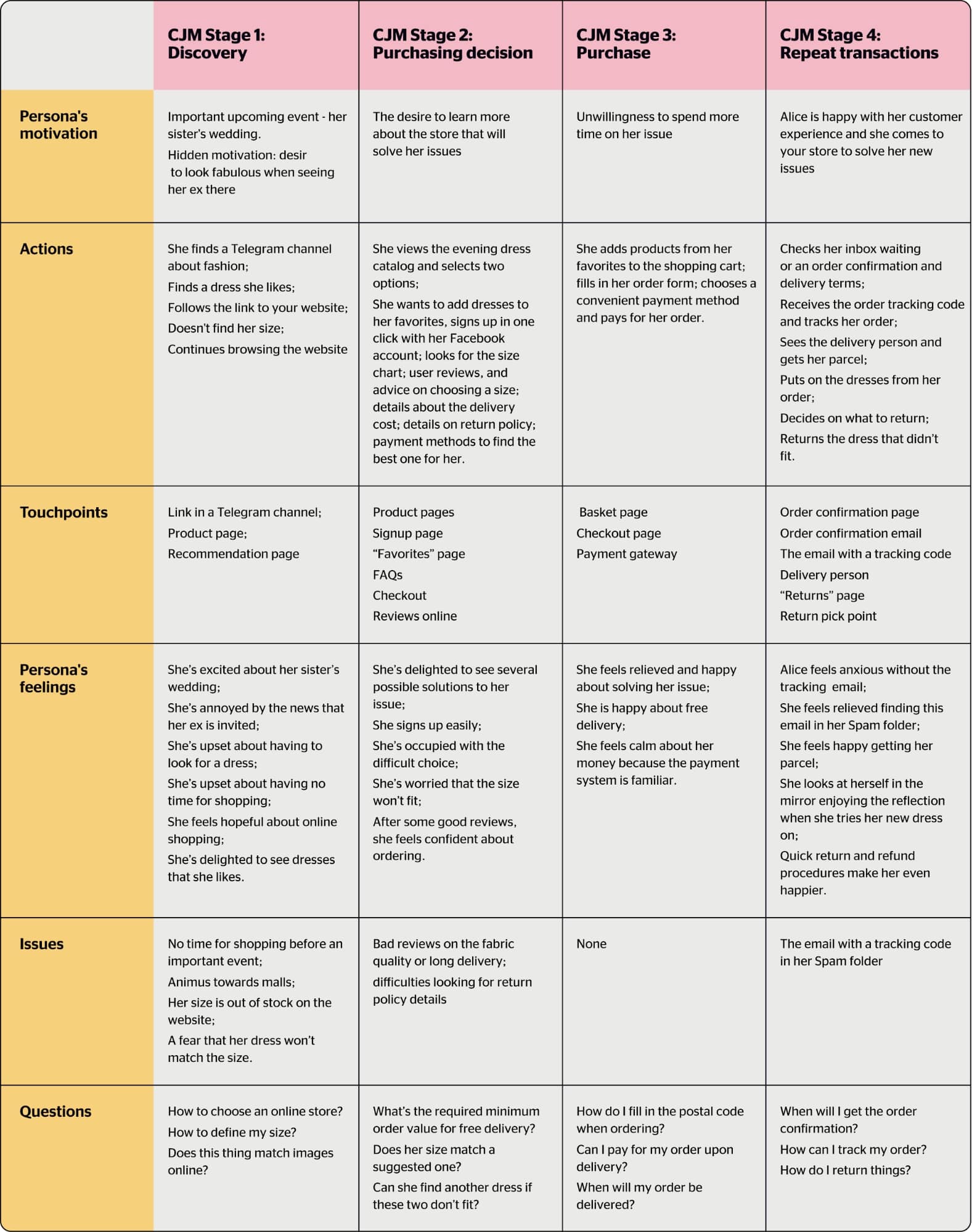
Stage five: Go over your customer journey map and handle bottlenecks
Look at what you’ve put down in your customer journey map. At what stage do most customers churn? What do they find the most difficult? What brings negative emotions? What do they doubt about?
You probably already have it all on your map. Work on your growth areas, improve your product, customer care & support, and everything that matters to your customer.
Alice’s journey map highlighted several bottlenecks: an email that went to Spam, bad reviews online, and the return policy details that were difficult to find. If that’s your case, work on transaction emails, encourage loyal customers to post their good reviews and make the returns section more visible.
Get a free website audit and improve your conversions with Dashly experts
Let’s schedule a 30-minute call and find out how to:
- Improve your website conversion.
- Grow your ROI/ROMI with proven hypotheses that fit your audience.
- Optimize or launch ad channels without additional budget.
- Decrease SLA workload by saving their time on lead processing.

Stage six: Start all over again
Designing the customer journey map means permanently reflecting on the customer experience. After you work on your growth areas, the customer’s journey changes, so go to stage one and begin all over again. Good luck!
Toolkit for designing the Customer Journey Map
For a wrap-up, we made a list of tools that you may find useful when designing maps:
Journey mapping and portraying buyer personas:
Surveys:
Read also:
- 3-step guide on inbound lead qualification: how to qualify inbound leads on autopilot
- How to implement user tracking on website: guide, tactics, and tools
- Top 10 user activity monitoring tools: tracking features, price, cons and pros
- Acquisition funnel marketing: Grow customer conversions at each step of user journey
- Top 12 lead qualification tools to deliver your sales hot leads only
- Top 20 best website tracking tools for effective work with visitors
![9 steps to master the growth hacking canvas strategy for your business [free template]](https://www.dashly.io/blog/wp-content/uploads/2023/05/Growth-hacking-canvas-free-templates-720x317.png)
![Build Ideal Customer Profile Like a Pro Even If You’re Not [3 Templates]](https://www.dashly.io/blog/wp-content/uploads/2021/03/ideal-customer-profile-4-720x308.jpg)


